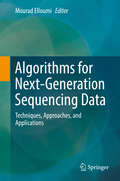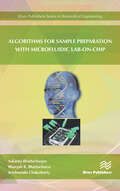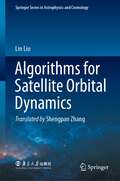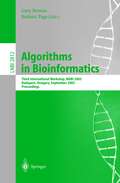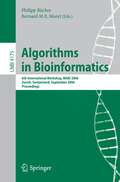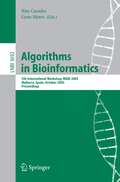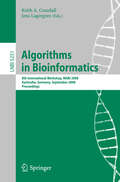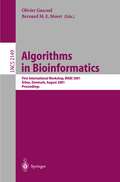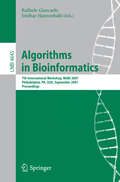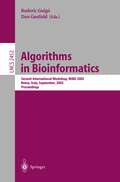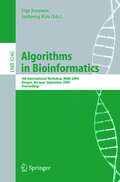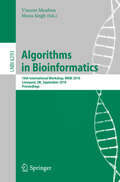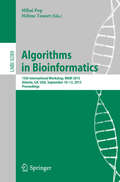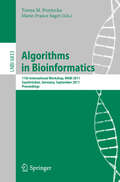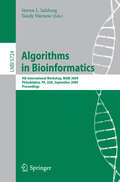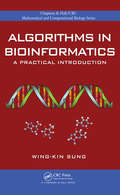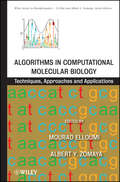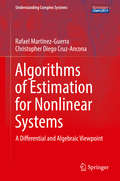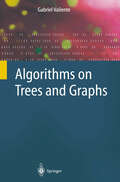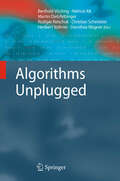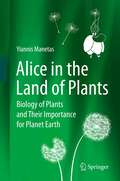- Table View
- List View
Algorithms for Next-Generation Sequencing Data: Techniques, Approaches, and Applications
by Mourad ElloumiThe 14 contributed chapters in this book survey the most recent developments in high-performance algorithms for NGS data, offering fundamental insights and technical information specifically on indexing, compression and storage; error correction; alignment; and assembly. The book will be of value to researchers, practitioners and students engaged with bioinformatics, computer science, mathematics, statistics and life sciences.
Algorithms for Sample Preparation with Microfluidic Lab-on-Chip
by Sukanta Bhattacharjee Bhargab B. Bhattacharya Krishnendu ChakrabartyRecent microfluidic technologies have brought a complete paradigm shift in automating biochemical processing on a tiny lab-on-chip (a.k.a. biochip) that replaces expensive and bulky instruments traditionally used in implementing bench-top laboratory protocols. Biochips have already made a profound impact on various application domains such as clinical diagnostics, DNA analysis, genetic engineering, and drug discovery, among others. They are capable of precisely manipulating micro-/pico-liter quantities of fluids, and provide integrated support for mixing, storage, transportation, and sensing, on-chip. In almost all bioprotocols, sample preparation plays an important role, which includes dilution and mixing of several fluids satisfying certain volumetric ratios. However, designing algorithms that minimize reactant-cost and sample-preparation time suited for microfluidic chips poses a great challenge from the perspective of protocol mapping, scheduling, and physical design. Algorithms for Sample Preparation with Microfluidic Lab-on-Chip attempts to bridge the widening gap between biologists and engineers by introducing, from the fundamentals, several state-of-the-art computer-aided-design (CAD) algorithms for sample preparation with digital and flow-based microfluidic biochips. Technical topics discussed in the book include: Basics of digital and flow-based microfluidic lab-on-chipComprehensive review of state-of-the-art sample preparation algorithmsSample-preparation algorithms for digital microfluidic lab-on-chipSample-preparation algorithms for flow-based microfluidic lab-on-chip
Algorithms for Sample Preparation with Microfluidic Lab-on-Chip
by Sukanta Bhattacharjee Bhargab B. Bhattacharya Krishnendu ChakrabartyRecent microfluidic technologies have brought a complete paradigm shift in automating biochemical processing on a tiny lab-on-chip (a.k.a. biochip) that replaces expensive and bulky instruments traditionally used in implementing bench-top laboratory protocols. Biochips have already made a profound impact on various application domains such as clinical diagnostics, DNA analysis, genetic engineering, and drug discovery, among others. They are capable of precisely manipulating micro-/pico-liter quantities of fluids, and provide integrated support for mixing, storage, transportation, and sensing, on-chip. In almost all bioprotocols, sample preparation plays an important role, which includes dilution and mixing of several fluids satisfying certain volumetric ratios. However, designing algorithms that minimize reactant-cost and sample-preparation time suited for microfluidic chips poses a great challenge from the perspective of protocol mapping, scheduling, and physical design. Algorithms for Sample Preparation with Microfluidic Lab-on-Chip attempts to bridge the widening gap between biologists and engineers by introducing, from the fundamentals, several state-of-the-art computer-aided-design (CAD) algorithms for sample preparation with digital and flow-based microfluidic biochips. Technical topics discussed in the book include: Basics of digital and flow-based microfluidic lab-on-chipComprehensive review of state-of-the-art sample preparation algorithmsSample-preparation algorithms for digital microfluidic lab-on-chipSample-preparation algorithms for flow-based microfluidic lab-on-chip
Algorithms for Satellite Orbital Dynamics (Springer Series in Astrophysics and Cosmology)
by Lin LiuThis book highlights the fundamental physics of orbit theory, dynamical models, methods of orbit determination, design, measurement, adjustment, and complete calculations for the position, tracking, and prediction of satellites and deep spacecraft. It emphasizes specific methods, related mathematical calculations, and worked examples and exercises. Therefore, technicians and engineers in the aerospace industry can directly apply them to their practical work. Dedicated to undergraduate students and graduate students, researchers, and professionals in astronomy, physics, space science, and related aerospace industries, the book is an integrated work based on the accumulated knowledge in satellite orbit dynamics and the author’s more than five decades of personal research and teaching experience in astronomy and aerospace dynamics.
Algorithms for the People: Democracy in the Age of AI
by Josh SimonsHow to put democracy at the heart of AI governanceArtificial intelligence and machine learning are reshaping our world. Police forces use them to decide where to send police officers, judges to decide whom to release on bail, welfare agencies to decide which children are at risk of abuse, and Facebook and Google to rank content and distribute ads. In these spheres, and many others, powerful prediction tools are changing how decisions are made, narrowing opportunities for the exercise of judgment, empathy, and creativity. In Algorithms for the People, Josh Simons flips the narrative about how we govern these technologies. Instead of examining the impact of technology on democracy, he explores how to put democracy at the heart of AI governance.Drawing on his experience as a research fellow at Harvard University, a visiting research scientist on Facebook’s Responsible AI team, and a policy advisor to the UK’s Labour Party, Simons gets under the hood of predictive technologies, offering an accessible account of how they work, why they matter, and how to regulate the institutions that build and use them.He argues that prediction is political: human choices about how to design and use predictive tools shape their effects. Approaching predictive technologies through the lens of political theory casts new light on how democracies should govern political choices made outside the sphere of representative politics. Showing the connection between technology regulation and democratic reform, Simons argues that we must go beyond conventional theorizing of AI ethics to wrestle with fundamental moral and political questions about how the governance of technology can support the flourishing of democracy.
Algorithms in Bioinformatics: Third International Workshop, WABI 2003, Budapest, Hungary, September 15-20, 2003, Proceedings (Lecture Notes in Computer Science #2812)
by Gary Benson Roderic PageAlgorithms in Bioinformatics: 6th International Workshop, WABI 2006, Zurich, Switzerland, September 11-13, 2006, Proceedings (Lecture Notes in Computer Science #4175)
by Philipp Bücher Bernard M. E. MoretHere are the refereed proceedings of the 6th International Workshop on Algorithms in Bioinformatics, WABI 2006, held in the course of the ALGO 2006 conference meetings. The book presents 36 revised full papers addressing all current issues of algorithms in bioinformatics, from mathematical tools to experimental studies of approximation algorithms and reports on significant computational analyses. For the first time, coverage extends to machine-learning approaches along with combinatorial optimization.
Algorithms in Bioinformatics: 5th International Workshop, WABI 2005, Mallorca, Spain, October 3-6, 2005, Proceedings (Lecture Notes in Computer Science #3692)
by Rita Casadio Gene MyersAlgorithms in Bioinformatics: 8th International Workshop, WABI 2008, Karlsruhe, Germany, September 15-19, 2008, Proceedings (Lecture Notes in Computer Science #5251)
by Keith Crandall Jens LagergrenThis book constitutes the refereed proceedings of the 8th International Workshop on Algorithms in Bioinformatics, WABI 2008, held in Karlsruhe, Germany, in September 2008 as part of the ALGO 2008 meeting. The 32 revised full papers presented together with the abstract of a keynote talk were carefully reviewed and selected from 81 submissions. All current issues of algorithms in bioinformatics are addressed, reaching from mathematical tools to experimental studies of approximation algorithms and reports on significant computational analyses. The topics range in biological applicability from genome mapping, to sequence assembly, to microarray quality, to phylogenetic inference, to molecular modeling.
Algorithms in Bioinformatics: First International Workshop, WABI 2001, Aarhus, Denmark, August 28-31, 2001, Proceedings (Lecture Notes in Computer Science #2149)
by Olivier Gascuel Bernard M. E. MoretAlgorithms in Bioinformatics: 7th International Workshop, WABI 2007, Philadelphia, PA, USA, September 8-9, 2007, Proceedings (Lecture Notes in Computer Science #4645)
by Raffaele Giancarlo Sridhar HannenhalliThe refereed proceedings from the 7th International Workshop on Algorithms in Bioinformatics are provided in this volume. Papers address current issues in algorithms in bioinformatics, ranging from mathematical tools to experimental studies of approximation algorithms to significant computational analyses. Biological problems examined include genetic mapping, sequence alignment and analysis, phylogeny, comparative genomics, and protein structure.
Algorithms in Bioinformatics: Second International Workshop, WABI 2002, Rome, Italy, September 17-21, 2002, Proceedings (Lecture Notes in Computer Science #2452)
by Roderic Guigo Dan GusfieldWe are pleased to present the proceedings of the Second Workshop on Al- rithms in Bioinformatics (WABI 2002), which took place on September 17-21, 2002 in Rome, Italy. The WABI workshop was part of a three-conference me- ing, which, in addition to WABI, included the ESA and APPROX 2002. The three conferences are jointly called ALGO 2002, and were hosted by the F- ulty of Engineering, University of Rome “La Sapienza”. Seehttp://www.dis. uniroma1.it/˜algo02 for more details. The Workshop on Algorithms in Bioinformatics covers research in all areas of algorithmic work in bioinformatics and computational biology. The emphasis is on discrete algorithms that address important problems in molecular biology, genomics,andgenetics,thatarefoundedonsoundmodels,thatarecomputati- ally e?cient, and that have been implemented and tested in simulations and on real datasets. The goal is to present recent research results, including signi?cant work in progress, and to identify and explore directions of future research. Original research papers (including signi?cant work in progress) or sta- of-the-art surveys were solicited on all aspects of algorithms in bioinformatics, including, but not limited to: exact and approximate algorithms for genomics, genetics, sequence analysis, gene and signal recognition, alignment, molecular evolution, phylogenetics, structure determination or prediction, gene expression and gene networks, proteomics, functional genomics, and drug design.
Algorithms in Bioinformatics: 4th International Workshop, WABI 2004, Bergen, Norway, September 17-21, 2004, Proceedings (Lecture Notes in Computer Science #3240)
by Inge Jonassen Junhyong KimAlgorithms in Bioinformatics: 10th International Workshop, WABI 2010, Liverpool, UK, September 6-8, 2010, Proceedings (Lecture Notes in Computer Science #6293)
by Vincent Moulton Mona SinghAlgorithms in Bioinformatics: 15th International Workshop, WABI 2015, Atlanta, GA, USA, September 10-12, 2015, Proceedings (Lecture Notes in Computer Science #9289)
by Mihai Pop Hélène TouzetThis book constitutes the refereed proceedings of the 15th International Workshop on Algorithms in Bioinformatics, WABI 2015, held in Atlanta, GA, USA, in September 2015. The 23 full papers presented were carefully reviewed and selected from 56 submissions. The selected papers cover a wide range of topics from networks to phylogenetic studies, sequence and genome analysis, comparative genomics, and RNA structure.
Algorithms in Bioinformatics: 11th International Workshop, WABI 2011, Saarbrücken, Germany, September 5-7, 2011, Proceedings (Lecture Notes in Computer Science #6833)
by Teresa M. Przytycka Marie-France SagotThis book constitutes the refereed proceedings of the 11th International Workshop on Algorithms in Bioinformatics, WABI 2011, held in Saarbrücken, Germany, in September 2011. The 30 papers presented were carefully reviewed and selected from 77 submissions. They cover aspects of algorithms in bioinformatics, computational biology and systems biology.
Algorithms in Bioinformatics: 9th International Workshop, WABI 2009, Philadelphia, USA, September 12-13, 2009. Proceedings (Lecture Notes in Computer Science #5724)
by Steven L. Salzberg Tandy WarnowThese proceedings contain papers from the 2009 Workshop on Algorithms in Bioinformatics (WABI), held at the University of Pennsylvania in Philadelphia, Pennsylvania during September 12–13, 2009. WABI 2009 was the ninth annual conference in this series, which focuses on novel algorithms that address imp- tantproblemsingenomics,molecularbiology,andevolution.Theconference- phasizes research that describes computationally e?cient algorithms and data structures that have been implemented and tested in simulations and on real data. WABI is sponsored by the European Association for Theoretical C- puter Science (EATCS) and the International Society for Computational Bi- ogy (ISCB). WABI 2009 was supported by the Penn Genome Frontiers Institute and the Penn Center for Bioinformatics at the University of Pennsylvania. For the 2009 conference, 90 full papers were submitted for review by the Program Committee, and from this strong ?eld of submissions, 34 papers were chosen for presentation at the conference and publication in the proceedings. The ?nal programcovered a wide range of topics including gene interaction n- works, molecular phylogeny, RNA and protein structure, and genome evolution.
Algorithms in Bioinformatics: A Practical Introduction (Chapman And Hall/crc Mathematical And Computational Biology Ser.)
by Wing-Kin SungThoroughly Describes Biological Applications, Computational Problems, and Various Algorithmic Solutions Developed from the author's own teaching material, Algorithms in Bioinformatics: A Practical Introduction provides an in-depth introduction to the algorithmic techniques applied in bioinformatics. For each topic, the author clearly details the bi
Algorithms in Computational Molecular Biology: Techniques, Approaches and Applications (Wiley Series in Bioinformatics #21)
by Mourad Elloumi Albert Y. ZomayaThis book represents the most comprehensive and up-to-date collection of information on the topic of computational molecular biology. Bringing the most recent research into the forefront of discussion, Algorithms in Computational Molecular Biology studies the most important and useful algorithms currently being used in the field, and provides related problems. It also succeeds where other titles have failed, in offering a wide range of information from the introductory fundamentals right up to the latest, most advanced levels of study.
Algorithms in Computational Molecular Biology: Techniques, Approaches and Applications (Wiley Series in Bioinformatics #16)
by Mourad Elloumi Albert Y. ZomayaThis book represents the most comprehensive and up-to-date collection of information on the topic of computational molecular biology. Bringing the most recent research into the forefront of discussion, Algorithms in Computational Molecular Biology studies the most important and useful algorithms currently being used in the field, and provides related problems. It also succeeds where other titles have failed, in offering a wide range of information from the introductory fundamentals right up to the latest, most advanced levels of study.
Algorithms of Estimation for Nonlinear Systems: A Differential and Algebraic Viewpoint (Understanding Complex Systems)
by Rafael Martínez-Guerra Christopher Diego Cruz-AnconaThis book acquaints readers with recent developments in dynamical systems theory and its applications, with a strong focus on the control and estimation of nonlinear systems. Several algorithms are proposed and worked out for a set of model systems, in particular so-called input-affine or bilinear systems, which can serve to approximate a wide class of nonlinear control systems. These can either take the form of state space models or be represented by an input-output equation. The approach taken here further highlights the role of modern mathematical and conceptual tools, including differential algebraic theory, observer design for nonlinear systems and generalized canonical forms.
Algorithms on Trees and Graphs
by Gabriel ValienteGraph algorithms is a well-established subject in mathematics and computer science. Beyond classical application fields, such as approximation, combinatorial optimization, graphics, and operations research, graph algorithms have recently attracted increased attention from computational molecular biology and computational chemistry. Centered around the fundamental issue of graph isomorphism, this text goes beyond classical graph problems of shortest paths, spanning trees, flows in networks, and matchings in bipartite graphs. Advanced algorithmic results and techniques of practical relevance are presented in a coherent and consolidated way. This book introduces graph algorithms on an intuitive basis followed by a detailed exposition in a literate programming style, with correctness proofs as well as worst-case analyses. Furthermore, full C++ implementations of all algorithms presented are given using the LEDA library of efficient data structures and algorithms.
Algorithms Unplugged
by Berthold Vöcking Rüdiger Reischuk Helmut Alt Martin Dietzfelbinger Christian Scheideler Heribert Vollmer Dorothea WagnerAlgorithms specify the way computers process information and how they execute tasks. Many recent technological innovations and achievements rely on algorithmic ideas – they facilitate new applications in science, medicine, production, logistics, traffic, communi¬cation and entertainment. Efficient algorithms not only enable your personal computer to execute the newest generation of games with features unimaginable only a few years ago, they are also key to several recent scientific breakthroughs – for example, the sequencing of the human genome would not have been possible without the invention of new algorithmic ideas that speed up computations by several orders of magnitude. The greatest improvements in the area of algorithms rely on beautiful ideas for tackling computational tasks more efficiently. The problems solved are not restricted to arithmetic tasks in a narrow sense but often relate to exciting questions of nonmathematical flavor, such as: How can I find the exit out of a maze? How can I partition a treasure map so that the treasure can only be found if all parts of the map are recombined? How should I plan my trip to minimize cost? Solving these challenging problems requires logical reasoning, geometric and combinatorial imagination, and, last but not least, creativity – the skills needed for the design and analysis of algorithms. In this book we present some of the most beautiful algorithmic ideas in 41 articles written in colloquial, nontechnical language. Most of the articles arose out of an initiative among German-language universities to communicate the fascination of algorithms and computer science to high-school students. The book can be understood without any prior knowledge of algorithms and computing, and it will be an enlightening and fun read for students and interested adults.
Alice in the Land of Plants: Biology of Plants and Their Importance for Planet Earth
by Yiannis ManetasWhy is it that plants do not need to move? How does a nonmotile organism have sex or defend itself? Why are some plants virtually immortal? What is the mechanism that allows plants to exploit a practically inexhaustible extraterrestrial energy source? How do plants regulate the composition of our planet’s atmosphere? Why have there not been mass extinctions among plants as there have been among animals? How do plants communicate with one another? In the end, are plants intelligent organisms?These are some of the questions the author discusses to demonstrate that plants are wrongly considered to be simple organisms lacking specific behaviour and intelligence. This book promises to be as pleasant a surprise as Alice’s experience in the white rabbit’s warren, in which she encountered a world very different from ours.The author explains the biology of plants following Einstein's maxim that everything should be made as simple as possible, but not simpler.
Alice in Wonderland: The children's classic with 20 hands-on STEAM projects (STEAM Tales)
by Katie Dicker Lewis CarrollFire up young readers' imagination and creativity with this classic story featuring added STEAM activities.This beloved children's adventure is retold with vivid and engaging new illustrations – and at the end of every chapter, there are exciting new science, technology, engineering, art and mathematics activities, themed around the events in the book. The activities range from simple puzzles to fun, dynamic experiments, so there's something for every enquiring mind. It's the ideal combination of enchanting story and stimulating science fun.
